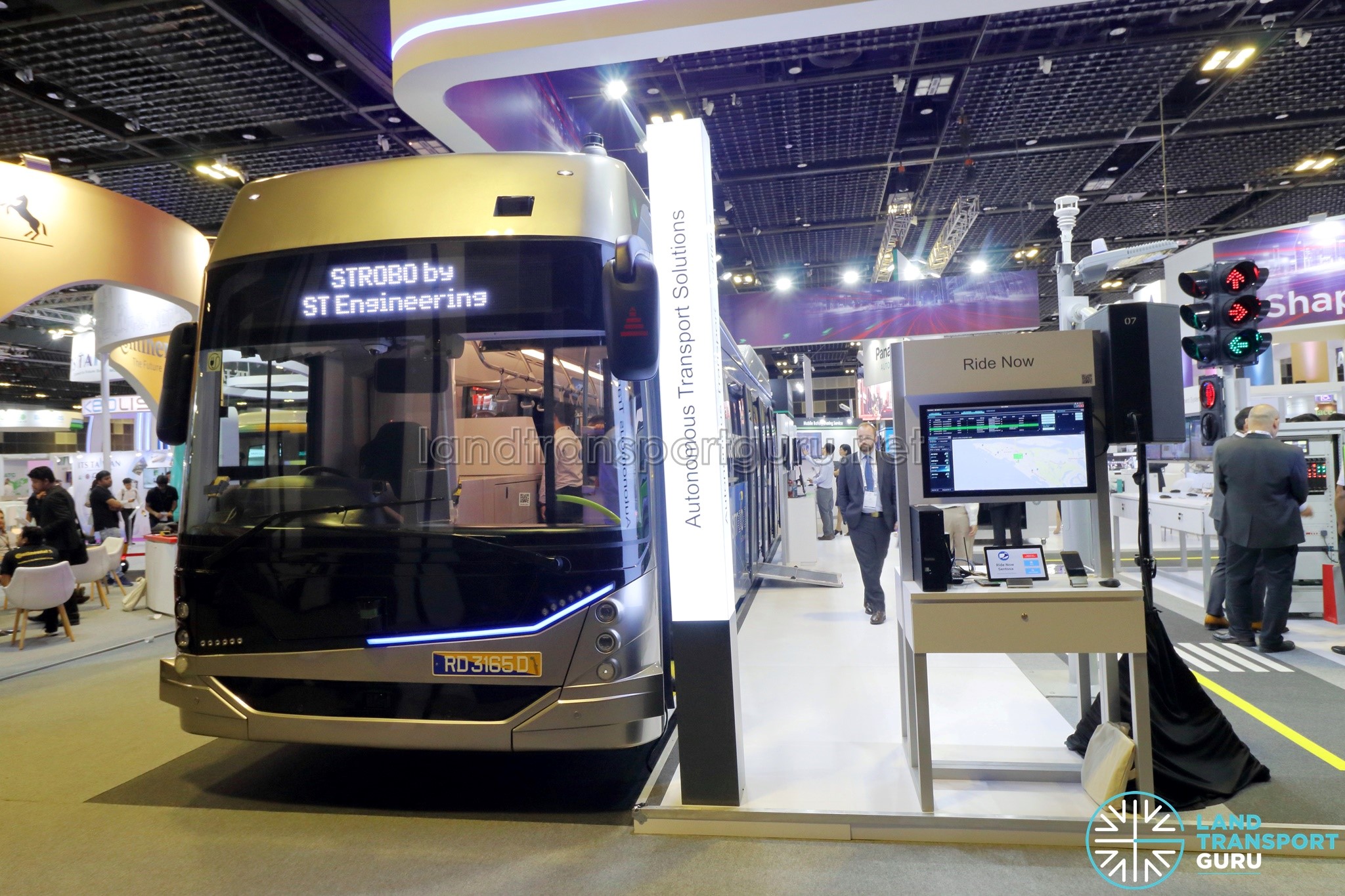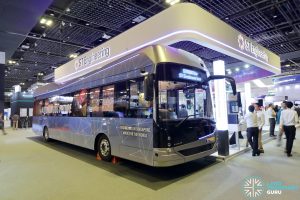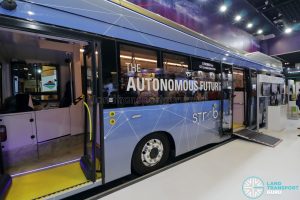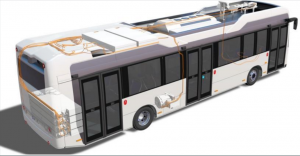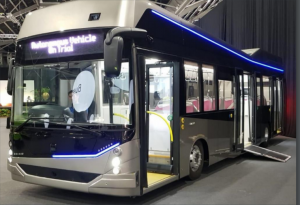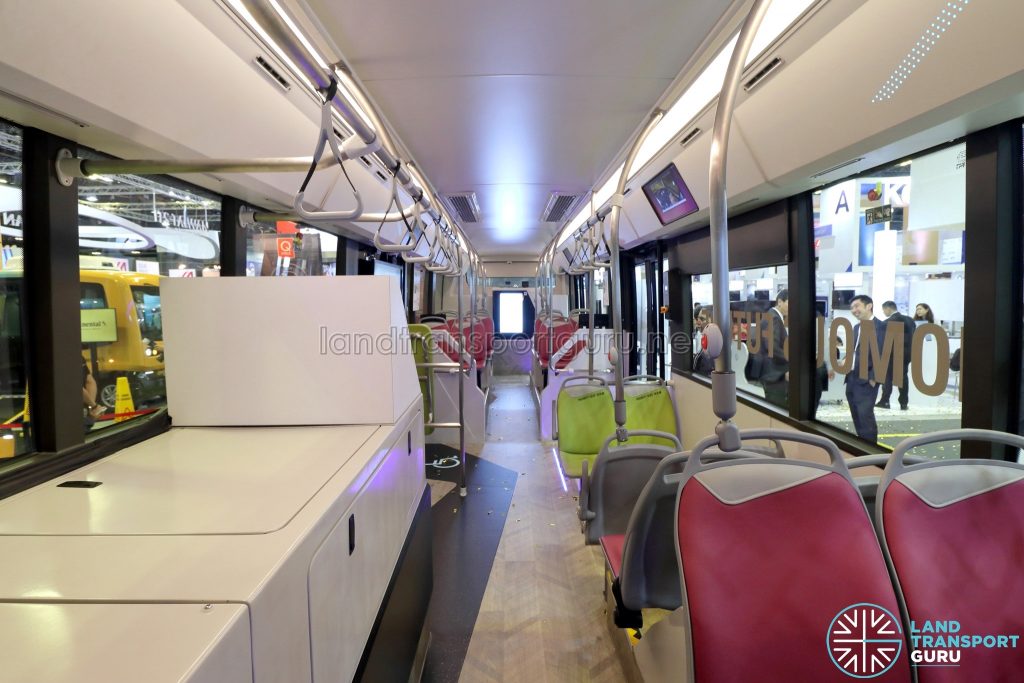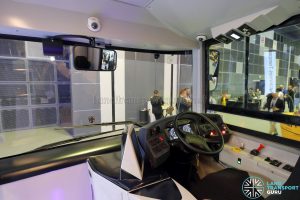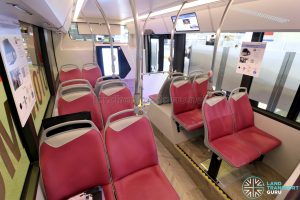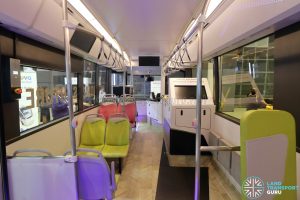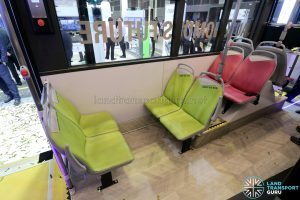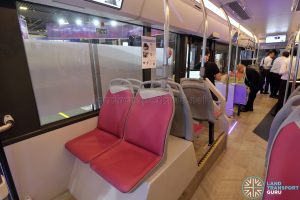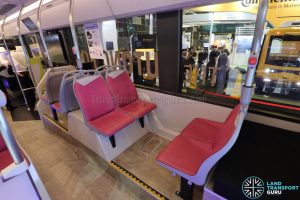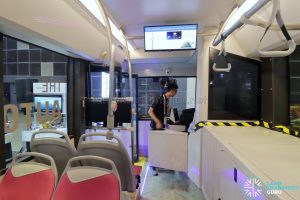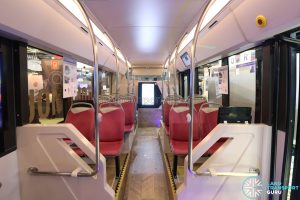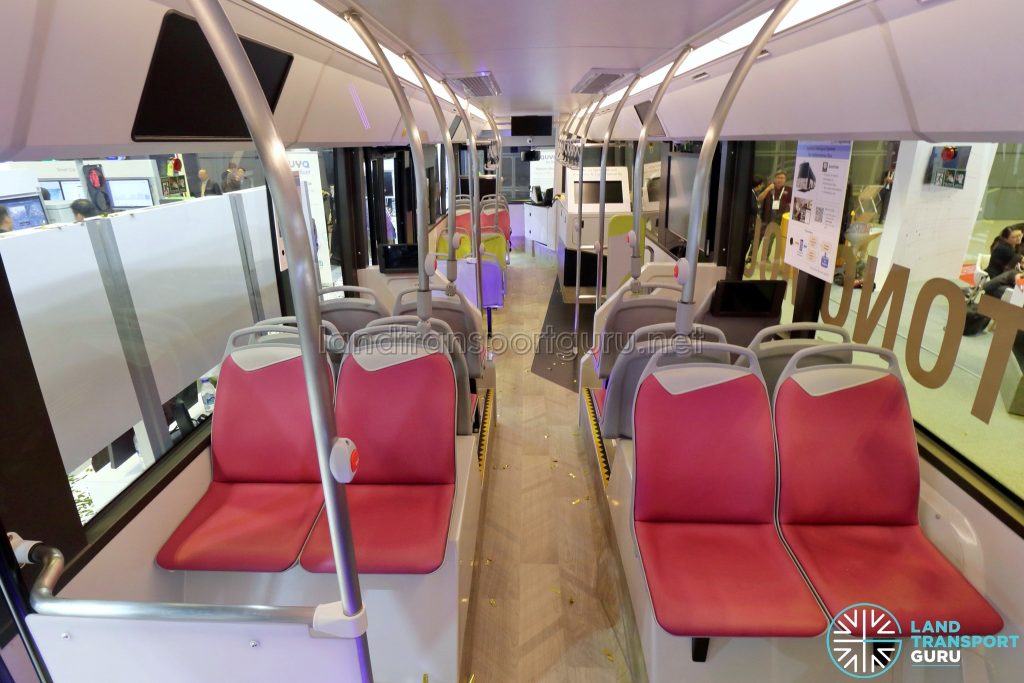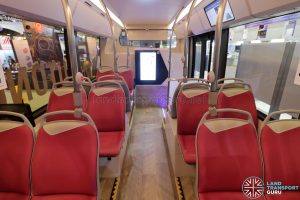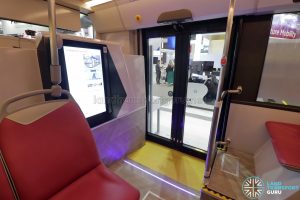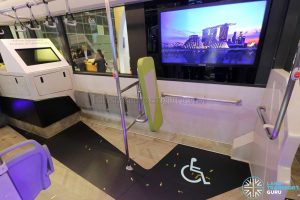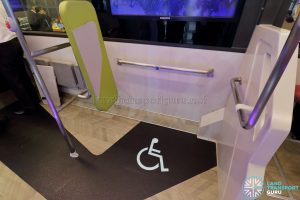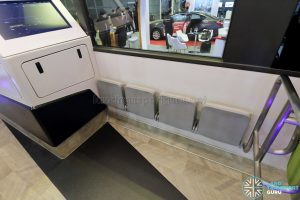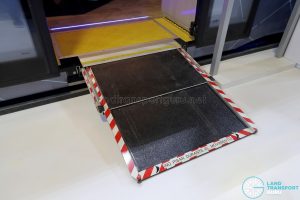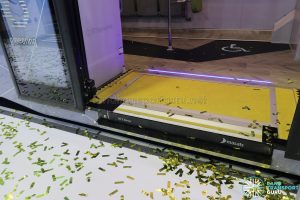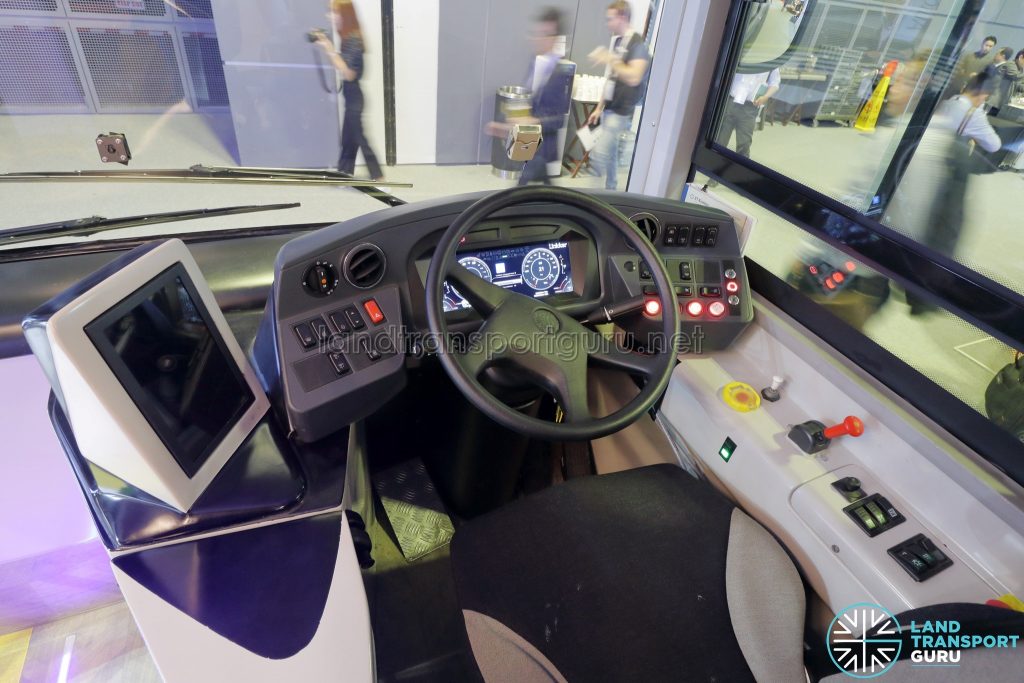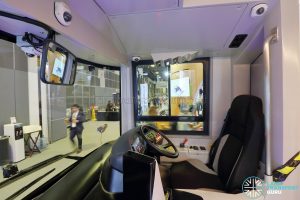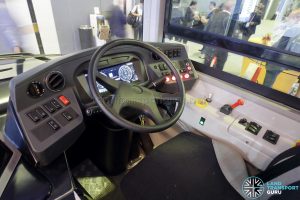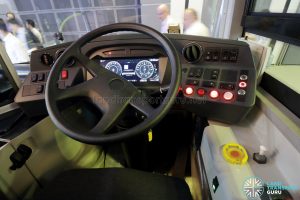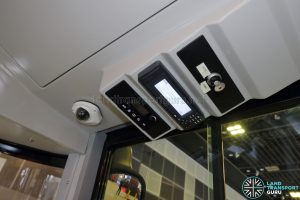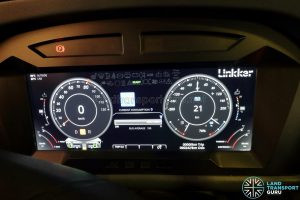The STROBO Series 12 Bus is a low-floor, autonomous, and fully-electric single-deck city bus built by ST Engineering Land Systems (formerly ST Kinetics) in partnership with Finnish electric vehicle manufacturer Linkker, and equipped for fully-autonomous operation.
The bus is primarily based on the Linkker 12 LF bus platform. For recharging, it uses the OppCharge opportunity charging interface, offering a range of roughly 50 kilometres. More information about OppCharge is detailed at the end of the article.
The STROBO Series 12 was first revealed in October 2018 by ST Engineering at a company event (Singapore Business Night) held at Singapore Expo. In October 2019, the bus was exhibited at the 26th Intelligent Transport Systems (ITS) World Congress, with the “STROBO” branding and with the Research and Development registration plate “RD3165D“.
This bus is one of two full-sized autonomous buses being developed by ST Engineering, the other being a Linkker 12+, and both buses have been tested on public roads within Jurong Island. Passenger trials along the same route were slated for mid-2020.
A similar bodywork design is used on the Linkker LM312, with 20 units expected to enter service by 2021.
Background Information:
Main Article: ST Engineering-Linkker Autonomous Electric Bus
Background Information (Click to expand)ST Engineering Land Systems (previously ST Kinetics) announced its intention to develop Autonomous Vehicle (AV) technologies on 10 April 2017. In a press release, the company also announced its intention to integrate these technologies into two 40-seater electric buses. These prototype vehicles would undergo a three-and-a-half-year period of road trials expected to begin in mid-2020, with potential test grounds being Jurong Island and the National University of Singapore (NUS)’ campus. The eventual goal was to develop autonomous buses capable of running fixed and scheduled bus services for intra- and inter-town travel.
Starting in June 2019, the STROBO Series 12 Bus embarked on road trials in Jurong Island, plying an extended route between Sakra Region and Jurong Island Checkpoint until early 2020, validating the technology (the proposed trial at NUS never materialised). Following that, two of these autonomous buses (likely the STROBO Series 12 Bus and the Linkker 12+) would then continue to undergo further public passenger operational trials in Jurong Island starting around June 2020. The bus will initially travel at a speed of about 20kmh, and is expected to increase to 50kmh eventually. The proposed trial at NUS never materialised.
The development and testing of the autonomous buses aimed to cover as many scenarios faced by bus services as possible, to deepen understanding of the current state of the technology, and to prepare for eventual full-scale operations in the future when the technology matures. In the longer term, it is envisaged that the trial could be extended to public roads in towns to enhance intra-town travel.
ST Engineering Land Systems’ STROBO portfolio brand of autonomous bus platforms was officially unveiled in October 2019 at the 26th ITS World Congress held in Singapore. Designed to meet urban traffic requirements and weather conditions, the STROBO Bus would offer customers more choices based on their operational requirements. The project is the result of collaborative efforts by the Singapore Autonomous Vehicle Research Consortium, which ST Engineering is part of, along with the Institute for Infocomm Research (I2R), National University of Singapore (NUS), Nanyang Technological University (NTU), and Singapore University of Technology and Design (SUTD).
The company has since developed niche AV technologies such as automotive cybersecurity, advanced autonomy and platform-agnostic AV kits. Through a build-test-deploy spiral approach, AV technologies are tested and demonstrated at different stages of development to reduce risk, enhance reliability and readiness for deployment.
See Also: Autonomous Buses in Singapore
ST Engineering STROBO Series 12 Autonomous Electric Bus (Linkker 12 LF) (Gemilang Coachworks):
These buses are based on the Linkker 12 LF low-floor city bus chassis. Unlike Linkker 12/12+ units operating in Europe, local units bear a significantly different exterior bodywork design (likely commissioned by ST Engineering), which is built and assembled by Malaysian bodybuilder Gemilang Coachworks. The unique bodywork design is characterized by asymmetric front and rear body panel designs, and a large roof attachment characterized by angled lines.
Electric drivetrain components are procured from Linkker, an electric bus manufacturer from Finland. Linkker had previously tested its buses domestically (in Helsinki, Espoo, Turku) and overseas in Copenhagen and Moscow. Electric motors and inverters are likely supplied by Danfoss, a Denmark-based engineering group.
The Linkker LM312, also built by a partnership of ST Engineering/Linkker/Gemilang Coachworks, bears a similar bodywork design without the additional roof attachments. All these buses are also OppCharge-compatible, fully-low-floor, and equipped with three doors for more efficient passenger movement.
| Basic Technical Specifications (STROBO Series 12) |
|
| Vehicle Description | Single Deck, Right-Hand Drive Electric Bus capable of Dual Mode Operation (Manual or Autonomous) |
| Dimensions | 12m (Length) x 2.55m (Width) x 3m (Height) |
| Weight |
Curb weight: 12,100 kg; Maximum laden weight: 15,500 kg |
| Drivetrain | Linkker LinkDrive drivetrain: 180 kW Permanent Magnet Motor, max torque 7.824 Nm at rear wheels Motor & inverter supplied by Danfoss Editron (model unknown) |
| Battery | Lithium–titanate oxide batteries: 63.5kWh Charged via overhead pantograph with secondary plug-in charging capability |
| Bodywork | ST Engineering / Gemilang Coachworks bodywork Full Low Floor layout |
| Seating Capacity | Configurable. Default Configuration: 26 Seated, 54 Standing, 1 Wheelchair |
| Maximum Operating Speed | Up to 50 km/h |
| Doors |
3 Door Configuration |
| Operating Range | Up to 50 km/charge, depending on operating scenarios |
| Charging Method |
Connected Pantograph Plug-In Connection (Optional) |
| Autonomous Capabilities | SAE Level 4 Autonomy Designed for urban city traffic environment, normal and rain (up to 30mm/h) weather conditions |
| Additional Features | Gorba Electronic Display Signage Masats door systems Masats RT1 Dual Telescopic Ramp Eberspächer Sütrak air-conditioning iris IRMA MATRIX Automatic Passenger Counting System (Entrance & Exit doors) Ster NewCity Seats TNT Surveillance Interior CCTVs Door movement area sticker |
The three-door prototype bus was delivered from Linkker to Gemilang in semi-knocked-down (SKD) form, with only the chassis and body frame. Gemilang performed the final assembly work, inclusive of the design and construction of the bus’ interior.
Interior
Passenger Cabin
The interior of the bus features 28 permanent seats. Being a low-floor bus, the bus offers step-free access along the entire length of the bus.
Grab poles and handgrips are located on both sides of the aisle. All seats also have hand grips to provide commuters with additional support. Metal stanchion poles and handlebars bear a brushed metal finish similar to that earlier used on the 3-door MAN Lion’s City SD Concept Bus.
Bus stopping bell-pushes are located around the bus cabin, either mounted to stanchion poles or on the pillars in-between windows. Emergency hammers are also located on these pillars.
Third Door
A third door at the rear allows commuters at the rear of the bus to exit more easily.
As an improvement over the MAN Lion’s City SD – 3-door Concept Bus, all exit doors are dual-leaf doors. The low-floor layout also negates the need for stairs leading to the exit door.
Wheelchair Bay
Wheelchair accessibility is offered via an automatic wheelchair ramp installed at the middle door (model: Masats RT1, similar to the MAN A95 trial). The STROBO Series 12 bus has one wheelchair bay located opposite the middle door, accommodating one passenger-in-wheelchair (PIW). An alighting bell for PIWs is located on the adjacent grab pole.
Beside the wheelchair bay is a standing area with four foldable seats.
Driver’s Compartment
The layout of the driver’s compartment is similar to that of the Linkker 12, with frequently-operated controls in close reach of the driver. The dashboard interface also features the Linkker logo. A screen on the left is used as an interface to the autonomous driving system.
More pictures:
Air-conditioning and electronic display sign controllers are mounted on the roof.
More Photos & content on the next page…

